

Reeves Turtle
(Mauremys reevesii)
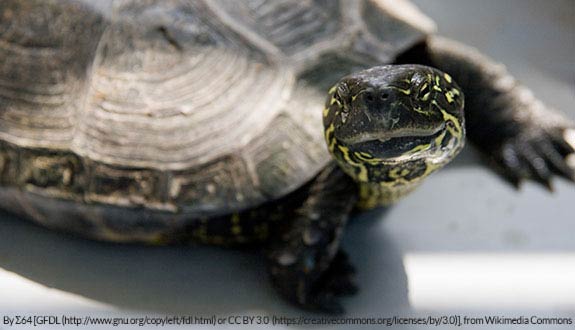
A big thank you to Valentin and Olivier!
Alternative species (click on the thumbnail to see the card)
Names
Scientific name
Mauremys reevesii
Chinemys reevesii
Common name
Reeves Turtle
Chinese pond turtle
Reeves' Turtle
Chinese Three-keeled Pond Turtle
Japanese Coin Turtle
Reeves' Three-keeled Pond Turtle
Origin

Origin: China, Japan, North Korea, South Korea, Taiwan
Biotope: Rivers, marshes, freshwater ponds. It is sometimes found in brackish water
Dimorphism
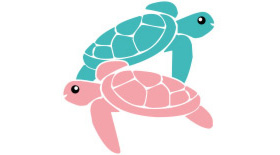
Males are much smaller than females and have the cloaca farther away from the base of the tail. Their tails are also longer and sharper.
Group
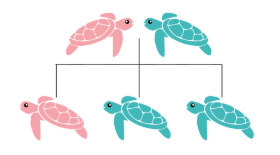
Geoemydidae
Length

For 1 specimen: 120x40x50 cm or 47x16x20"
Temperatures

Hot spot (beach): 29/30°C or 84/86°F
Water: 24/25°C or 75/77°F
Difficulty

Easy
Size

15 to 22 cm (6 to 7")
Longevity

15 to 20 years
Zone
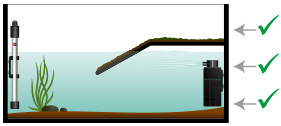
Earth (beach) and water
Individuals
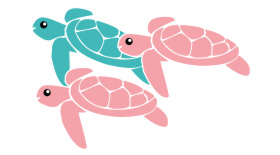
1
Food
How to feed the Reeves Turtle?
Food
How to feed the Reeves Turtle?
These are omnivorous turtles but they tend to like more and more plants as they grow.
Thus, you can make its basic food with the following fresh foods (none of these foods should be dried, fried or cooked):
- - Plants: elodea, lentils, endives, dandelion leaves, broccoli stems, spinach
- - Insects: crickets, mealworms (pay attention to pesticides if taken from the wild)
- - Slugs (in this case, watch out for water pollution)
- - Meat (turkey fillet, chicken, never red meat!). More occasionally, you can offer poultry liver or beef, rich in vitamin A
- - Fish: choose preferably freshwater species. For seawater, take small fish and cold water.
- - Fresh shrimp
- - Small snails with their shells
Complete with:
- - Vitamin supplement once or twice a week
- - A dry bone permanently available in the tray
- - From time to time: good quality commercial foods (like Zoomed)
- - Eventually supplement with calcium food, but this is not mandatory if the diet is sufficiently varied, rich and of good quality.
In terms of quantity, give the equivalent of the volume of the head per meal (this corresponds roughly to the volume of the stomach).
Mauremys babies should be fed daily for the first few months of life.
Once an adult, the frequency of meals will be 3 to 5 times a week.
Behavior
What kind of behavior does the Reeves Turtle have?
Behavior
What kind of behavior does the Reeves Turtle have?
It is a diurnal species. It spends a lot of time looking for its food actively by searching its environment and using all the space available. It is a good swimmer (however not as much as the famous Florida turtles). So, put a water level equivalent to about two and a half times the length of the plastron.
In terms of intraspecific relations, like almost all aquatic turtles, they are rather territorial and it is better to maintain them alone or in large tank to avoid any worries.
Cohabitation
Who can live with the Reeves Turtle?
Cohabitation
Who can live with the Reeves Turtle?
Like all aquatic turtles, Mauremys reevesii are very territorial. As a result, it can easily be alone on its territory.
However, if you want to keep several specimens, know that cohabitation works better between two females. Indeed, the cohabitation between two males is impossible. In the case of couple maintenance, it is only possible during the breeding season, for about one or two months. After that, it will be necessary to separate the lovers because the male will harass continuously the female until it exhausts completely. The solution to this problem is to have 1 male for 2 females. In this case, cohabitation can work.
However, even with all the precautions, there is always a risk of too much dominance of one individual over the other, regardless of sex. The dominated turtle will spend all its time hiding and stressing, eventually ending up weakened and prone to disease. It may also be that it stops eating completely and it would be in grave danger. All this to say that if you opt for a cohabitation of several turtles, there is always a risk that it goes wrong. You will then have to assume a second installation to separate the individuals. Cohabitation must therefore be carefully considered!
Breeding
How to breed the Reeves Turtle?
Breeding
How to breed the Reeves Turtle?
In the wild, mating takes place in the spring and laying occurs from May to August.
Males mature around age 4 while females reach sexual maturity around age 7.
Prepare a laying surface. To do this, replace the beach with a spawning box wide enough for the female to walk and maneuver freely and with a depth equal to one time the total length of the turtle at depth. Fill this tray with soil, peat and sand.
Put the male and two females in contact while some mating occurs, then separate them. Each year, you can expect several eggs with 4 to 9 elliptical eggs.
Once the female has laid, recover the eggs gently, making sure not to turn them, and place them in an incubator at a temperature of about 29/30°C or 84/86°F for +-90% humidity.
The incubation period is about 90 days. Small turtles should be fed daily.
Its Paludarium
Which Paludarium for the Reeves Turtle?
Its Paludarium
Which Paludarium for the Reeves Turtle?
For the "water" part, you can cover the bottom of the Paludarium with a substrate to make it more aesthetic, realistic, and facilitate the movement of the turtle. However, choose a very fine grain size sand to avoid a problem of intestinal obstruction in case of accidental ingestion. Also install hiding places and plants. Real plants will be very popular: the turtle will eat, uproot, tear them... A real pleasure! Make sure the proposed plants are not toxic. Tip: grow and breed your plants in a small tray separately;). That said, plastic plants can do the trick. Adjust the water level to about two-and-a-half times the plastron length, and heat it to about 24/25°C or 75/77°F.
On the beach side, it must be big enough. Indeed, the Mauremys reevesii likes to get out of the water to heat up in the sun quite often, and must find a comfortable place! In addition, this place of exposure and rest must be easy to access: a ramp not too steep is essential. The beach will be heated by a lamp at about 29/30°C or 84/86°F (5°C or 10°F more than water). A UV lamp 5.0 (= 5% depending on brands) is also essential. Note that there are now lamps that combine the heating side and UV, like the 2 in 1 Solar Raptor lamp for example. Install the UV lamp at 20 cm or 8 inches above the beach because beyond this distance, the loss of UV is too important and the amount that the turtle receives is not important enough (small info: the UV does not cross the water). Establish a day/night cycle from 12h to 14h.
Good To know
Find all additional information!
Good To know
Find all additional information!
Species listed in Appendix 3 of CITES, and therefore requires a certificate of capacity for maintenance in France.
This is because Mauremys reevesii is a threatened species because populations are declining in its natural environment.
Yours photos!
Comments
Sort by:
Please login to post comments

para - By Emys - Le 29-08-2021 15:44:28
TB fiche, sauf l'information t° de l'eau : pas utile de chauffer l'eau en bac intérieur, sauf juvénile (autour de 22° suffit) avant 1 an. Les reevesii hibernent localement et peuvent vivre dehors selon climat